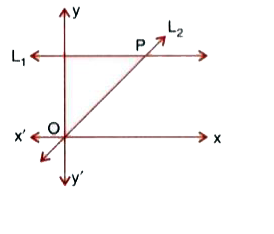Lines L1 and L2 have slopes m and n, respectively, suppose L1 makes twice as large angle with the horizontal (mesured counter clockwise from the positive x-axis as does L2 and L1 has 4 times the slope of L2. If L1 is not horizontal, then the value of the proudct mn equals.
The correct Answer is:2
To solve the problem, we need to find the product of the slopes m and n of the lines L1 and L2, given that L1 makes twice the angle with the horizontal as L2 and that m=4n.
1. Identify the Angles:
Let the angle that line L2 makes with the horizontal be θ. Therefore, the angle that line L1 makes with the horizontal is 2θ.
2. Express Slopes in Terms of Angles:
The slopes of the lines can be expressed using the tangent function:
- For line L2: n=tan(θ)
- For line L1: m=tan(2θ)
3. Use the Double Angle Formula:
We know from trigonometry that:
tan(2θ)=2tan(θ)1−tan2(θ)
Substituting for m:
m=2n1−n2
4. Relate Slopes:
We are given that m=4n. Therefore, we can set up the equation:
2n1−n2=4n
5. Cross Multiply:
To eliminate the fraction, we cross-multiply:
2n=4n(1−n2)
6. Expand and Rearrange:
Expanding the right side gives:
2n=4n−4n3
Rearranging this leads to:
4n3−2n=0
7. Factor the Equation:
Factoring out 2n:
2n(2n2−1)=0
8. Solve for n:
This gives us two cases:
- 2n=0 (which we discard since L1 is not horizontal)
- 2n2−1=0 leading to n2=12 or n=1√2
9. Find m:
Since m=4n:
m=4⋅1√2=4√2=2√2
10. Calculate the Product mn:
Now, we find the product mn:
mn=m⋅n=(2√2)⋅(1√2)=2
Final Answer:
The value of the product mn is 2.
Let the angle that line L2 makes with the horizontal be θ. Therefore, the angle that line L1 makes with the horizontal is 2θ.
The slopes of the lines can be expressed using the tangent function:
- For line L2: n=tan(θ)
- For line L1: m=tan(2θ)
We know from trigonometry that:
tan(2θ)=2tan(θ)1−tan2(θ)
Substituting for m:
m=2n1−n2
We are given that m=4n. Therefore, we can set up the equation:
2n1−n2=4n
To eliminate the fraction, we cross-multiply:
2n=4n(1−n2)
Expanding the right side gives:
2n=4n−4n3
Rearranging this leads to:
4n3−2n=0
Factoring out 2n:
2n(2n2−1)=0
This gives us two cases:
- 2n=0 (which we discard since L1 is not horizontal)
- 2n2−1=0 leading to n2=12 or n=1√2
Since m=4n:
m=4⋅1√2=4√2=2√2
Now, we find the product mn:
mn=m⋅n=(2√2)⋅(1√2)=2
The value of the product mn is 2.
Topper's Solved these Questions
- COORDINATE SYSYEM Book:CENGAGE ENGLISHChapter:COORDINATE SYSYEM Exercise:JEE Main
Explore 6 Videos
- COORDINATE SYSYEM Book:CENGAGE ENGLISHChapter:COORDINATE SYSYEM Exercise:Matrix match type
Explore 4 Videos
- COORDINATE SYSTEMBook:CENGAGE ENGLISHChapter:COORDINATE SYSTEMExercise:Multiple Correct Answers Type
Explore 2 Videos
- CROSS PRODUCTS Book:CENGAGE ENGLISHChapter:CROSS PRODUCTS Exercise:DPP 2.2
Explore 13 Videos
Similar Questions
The eqautions of lines L1andL2 are y=mxandy=nx, respectively. Suppose L1 makes twice as large an angle with the horizontal (measured counterclockwise from the positive x - axis) as does L2 and m = 4n, then the value of (m2+4n2)(m2−6n2) is equal to (where, n≠0)
View SolutionGiven equation of line L1 is y=4

Write the slope of line L1 if L2 is the bisector of angle O.
View SolutionIn the given figure, Given equation of line L1 is y = 4.
Write the slope of line L2 if L2 is the bisector of angle O.

View SolutionConsider three converging lenses L1,L2andL3 having identical geometrical construction. The index of refraction of L1andL2areμ1andμ2 respectively. The upper half of the lens L3 has a refractive index μ1 and the lower half has μ2. A point object O is imaged at O1 by the lens L1andatO2 by the lens L2 placed in same position . If L3 is placed at the same place.

View SolutionLines L1≡ax+by+c=0 and L2≡lx+my+n=0 intersect at the point P and make an angle θ with each other. Find the equation of a line different from L2 which passes through P and makes the same angle θ with L1.
View Solutionθ1andθ2 are the inclination of lines L1andL2 with the x-axis. If L1andL2 pass through P(x1,y1), then the equation of one of the angle bisector of these lines is
View Solutionlines L1:ax+by+c=0 and L2:lx+my+n=0 intersect at the point P and make a angle θ between each other. find the equation of a line Ldifferent from L2 which passes through P and makes the same angle θ with L1
View Solutionl1andl2 are the side lengths of two variable squares S1,andS2, respectively. If l1=l2+l32+6 then rate of change of the area of S2, with respect to rate of change of the area of S1 when l2=1 is equal to
View SolutionTwo lines L1 and L2 of slops 1 are tangents to y2=4x and x2+2y2=4 respectively, such that the distance d units between L1andL2 is minimum, then the value of d is equal to
View SolutionConsider two lines L1andL2 given by x−y=0 and x+y=0 , respectively, and a moving point P(x,y). Let d(P,L1),i=1,2, represents the distance of point P from the line Lt If point P moves in a certain region R in such a way that 2≤d(P,L1)+d(P,L2)≤4 , find the area of region R.
View Solution